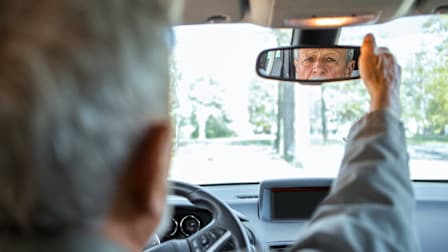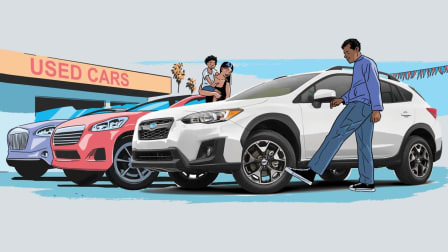How to Escape Your Car If the Electronic Door Handle Fails
Many newer cars have replaced the tried-and-true door handle with complex electronic versions. Here’s how to operate their manual releases in an emergency.
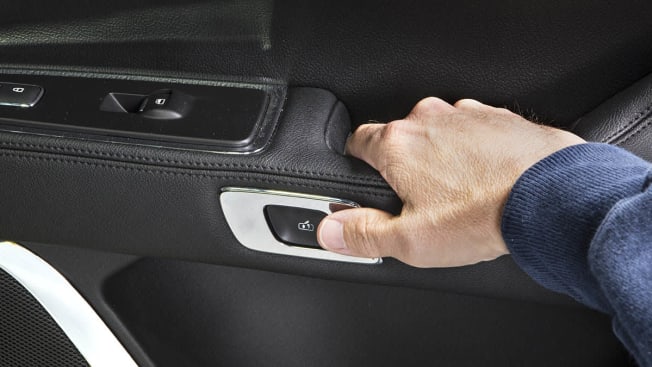
Instead of a simple, familiar mechanical latch, it’s now common for a car’s exterior door handles to remain flush against the door until the car is unlocked, requiring an electric motor to open. On many vehicles, interior door handles have been replaced by buttons that also need electricity and motors to work. It’s innovation but with mixed results.
To make matters worse, these electronic handles may not work if the car loses power or after a crash. Manual emergency releases on the interior exist, but they may be difficult to find or operate—especially in the panic of an emergency situation.
@consumerreports Keith Barry, autos reporter at CR, shares why drivers of some modern vehicles should learn where emergency door releases are located—before they need them. #cartok #carsoftiktok #cartips
♬ original sound - Consumer Reports
Why Are Carmakers Reinventing the Door Handle?
Automakers have told CR that these systems can save weight and add extra features. Some can automatically unlock during a crash, or prevent a passenger from opening a door in the path of an oncoming car or cyclist. Flush exterior door handles reduce drag and can improve aerodynamic efficiency, which is why they’re popular on many newer electric vehicles, ranging from the most expensive Lucid and Mercedes-Benz to the less pricey Chevrolet Equinox EV.
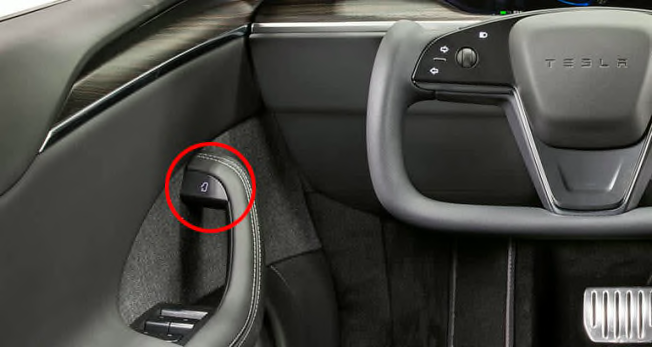
Photo: John Powers/Consumer Reports Photo: John Powers/Consumer Reports
Why Are Electronic Door Handles Such a Problem?
Concern about these handles is growing after a series of high-profile crashes—some resulting in fatalities—and a major recall.
• Canadian authorities are investigating an October 2024 Tesla crash in Toronto in which witnesses reported they were unable to open the vehicle’s doors from the outside. According to the CBC, four people were killed inside the vehicle, but one person was saved by a passing driver who was able to break the rear window glass.
• A 2019 lawsuit alleged that the door handles of Omar Awan’s Tesla Model S contributed to his death in a post-crash fire. The vehicle “remained inaccessible and locked, preventing the police officer and other bystanders who had arrived on the scene from opening the doors or finding another way to remove Dr. Awan from the car.” The case was dismissed in 2022.
• In 2022 the owner of a Tesla Model Y that caught fire in North Vancouver, British Columbia, told a local CTV News station that its electrically operated doors wouldn’t open, trapping him inside. He said that in his panic, he couldn’t figure out how to operate the emergency interior door release and kicked through the window to escape.
• From September 2024 through January 2025, an open recall meant that Volkswagen couldn’t sell any ID.4 EVs because their doors could suddenly open if the electronic handles got wet.
Plenty of other examples have made the news. A Rivian R1S owner told a Florida TV station in December 2024 that she was trapped in her vehicle due to an electrical short for 45 minutes while firefighters researched how to open the doors. Tesla drivers in Arizona and Chicago needed help from roadside assistance to find an emergency door release. And in 2018, the 75-year-old owner of a 2006 Cadillac XLR was trapped inside his vehicle for 14 hours after its battery died because he couldn’t find the manual release.
At Consumer Reports, we’ve also had to deal with electronic door handles on the cars we test. We’ve been stuck inside cars, locked out of them, and forced to chip away at ice to get the door handles to present themselves. More than once we’ve had to give a friend, family member, or valet an impromptu course on how to open the door, which should be one of the simplest functions on a vehicle.
How to Manually Open Electronic Doors From the Inside
In addition to all of Tesla’s models, vehicles including the Audi E-Tron, BMW iX, Chevrolet Corvette, Fiat 500e, Ford Mustang Mach-E, Genesis G90, Lexus NX, RX, and TX, Lucid Air, and the discontinued Fisker Ocean and Lincoln Continental also make use of electronic interior door releases. All of these also have some sort of manual release mechanism that may not be immediately apparent.
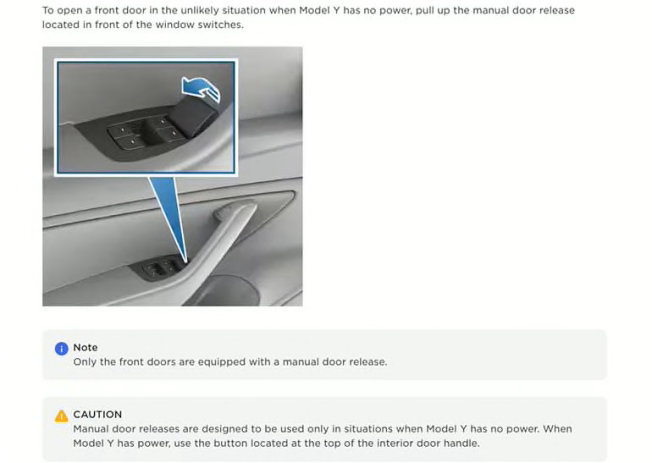
Photo: Tesla Photo: Tesla
• The owner’s manual for the Audi E-Tron says its doors can be opened mechanically by pulling the handle “forcefully” and “beyond its noticeable resistance” twice.
• For BMW vehicles, a manual door release is below the unlock button, near the storage pocket.
• In the Chevrolet Corvette and the discontinued Cadillac XLR, both from General Motors, the emergency door release is on the floor between the doors and the sills of the car. Pull up the lever and the door will open.
• On the Fiat 500e, the interior doors can be opened manually from the inside by pulling the manual door handle located on each door
• To open the Fisker Ocean’s doors manually from inside, pull the handle twice.
• In the Ford Mustang Mach-E, the door handle inside the door armrest doubles as a manual release. Pull it back further and the door will open.
• In the Genesis G90, pull the emergency open lever under the door pocket twice to open the door.
• The Lexus “Digital Latch”—common in most newer Lexus vehicles—can be overridden by pulling the door lever toward you twice instead of pushing it once. A Lexus spokesperson told CR that all four doors have an override.
• The Lincoln Continental has an emergency door release lever at the front of the storage pocket at the bottom of the door.
• Lucid says to pull the interior handle even further to release the door manually. This may take some effort.
• Maserati has an emergency release handle inside the front door pocket below the door handle.
• On 2025 and newer Rivian R1T pickup trucks and R1S SUVs, there’s now a manual door release handle behind the electronic door release button.
• The Tesla Model 3, Model Y, and 2021-and-newer Tesla Model S and Model X all have a manual door release lever for the front doors behind the electronic door release button. The image below from the owner’s manual shows where the lever is and how to use it.
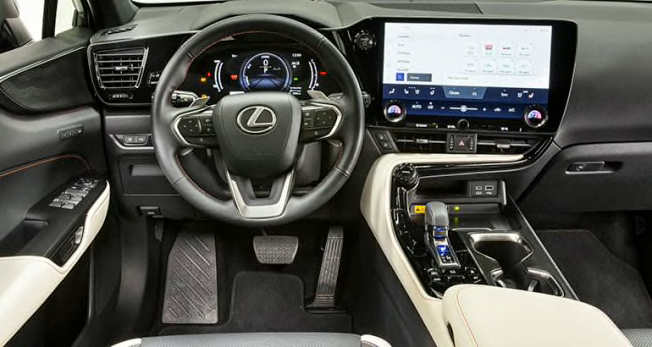
Photo: John Powers/Consumer Reports Photo: John Powers/Consumer Reports
What About Opening the Rear Doors From the Inside?
Some vehicles with electronic interior door releases—including some older Tesla Model Y and Model 3 vehicles—don’t have a manual rear door release. Others have more complex ones:
• On the 2025 and newer Rivian R1T and R1S, opening the rear door manually requires pulling off a door panel to the left of the electronic handle and pulling down on a release cord.
• 2024 and newer Tesla Model 3 sedans have a release hidden under a slot in the rear door pocket. Pop the cover off and pull the mechanical release cable forward.
• On a newer Tesla Model Y, remove the mat from the bottom of the rear door pocket, press the red tab to remove an access door that reveals a mechanical release cable, and pull the cable.
• In a Tesla Model X with nonfunctioning powered rear “falcon” doors, you must first remove a speaker grille before pulling on a release cable and manually pushing the door up.
• In the Tesla Model S, Tesla says to fold back the edge of the carpet below the rear seats to expose the mechanical release cable and pull the cable toward the center of the vehicle.
According to the safety advocacy group Kids and Cars, if the rear doors don’t open from inside the car, rear-seat passengers should use the front doors to exit a vehicle in an emergency. If that’s not possible, they should turn on the vehicle’s hazard lights, honk the horn, or otherwise try to make themselves visible to passersby.
All modern cars have child safety door locks that, when activated, prevent the rear doors from being opened from inside the vehicle. They’re designed to keep kids from opening the rear doors, but the safety feature can lead to rear-seat occupants being unable to open the doors in an emergency. Your car’s owner’s manual will tell you how to disengage these locks if you want occupants to be able to open the rear doors from inside the vehicle. They’re usually engaged and disengaged via a toggle in a slot on the inside of the car door or doorjamb.
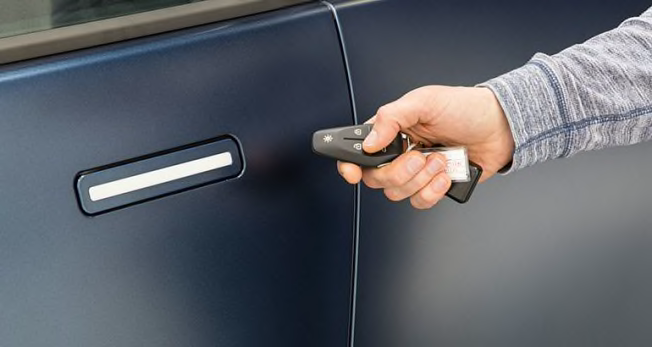
Photo: John Powers/Consumer Reports Photo: John Powers/Consumer Reports
Do You Need a Hammer?
Many auto supply stores sell spring-loaded “escape tools” that can smash a car’s window from the inside to give occupants another way of exiting in an emergency.
But beware that another wrinkle of modern technology may render some of these tools useless. Strong, laminated glass can keep occupants from being ejected from a vehicle in a crash and can also make for a quieter interior, but it’s harder to break than traditional tempered glass.
In 2019 AAA tested six escape tools on vehicles with laminated glass and found that none of them were able to break it. The group recommends looking at the labels printed on the corners of the glass on your car’s windows, sunroof, and windshield to determine what they’re made of. If your car has a tempered glass panel, remember where it is; in an emergency, tempered glass should be the easiest to break.
How to Manually Open Flush Exterior Door Handles
All vehicles with flush exterior door handles have some backup method of opening the vehicle, usually by pressing on the door handle while touching the key fob to a specific place on the vehicle. But these may not work if the car’s battery is dead or its electrical system is damaged. Check your owner’s manual for the specifics.
Some vehicles, such as the Range Rover Velar, have a manual key inside the key fob that can unlock the vehicle. If you press on the flush door handle manually, one side of it can flip out to reveal a lock where the owner can insert the manual key.
On some vehicles, including all Tesla models, the Ford Mustang Mach-E and Fisker Ocean, there’s no easy way to unlock the door from outside if the vehicle’s 12V battery is dead, aside from jumping it. Instructions on how to do so are in the owner’s manual.
Many vehicles also have specific instructions for what to do if the door handles freeze over when sitting flush. The specifics differ from vehicle to vehicle. Tesla recommends using the vehicle’s phone app to force the door handles to present themselves. If that doesn’t work, it has a complex series of instructions about where to “forcefully bump” the door handle with your fist. The instructions differ based on the color of the handle.
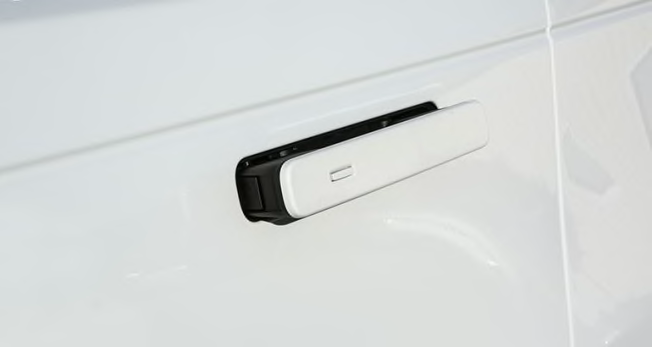
But these methods aren’t immediately obvious or simple to use, so you should learn how to operate them before you end up locked out with a dead battery or in another kind of emergency. Be prepared. The Genesis G90 devotes 40 pages of its owner’s manual to various methods of unlocking the doors from the outside.
Another reason to study up ahead of time: Some of these cars also have electronic releases on their glove boxes, making printed owner’s manuals impossible to access if they get locked inside. Others have virtual owner’s manuals that may not be accessible if you’re parked somewhere without a phone or internet connection, or if the battery is dead.
Many vehicles with flush exterior door handles also have phone-based keys or remote lock/unlock functions that can be used if you lock yourself out of the vehicle. Familiarize yourself with them before you have to use them.


















